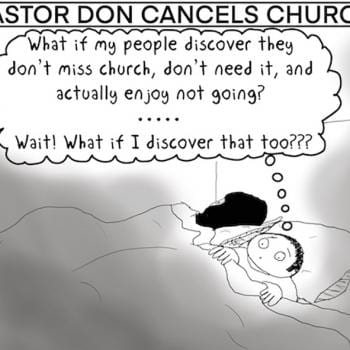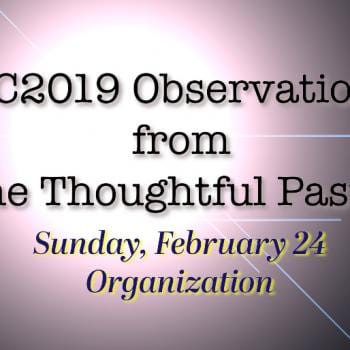I hear the word “toxic” bandied about all the time, both applied to people and to churches. The word means poisonous, of course. Poison is “a substance with an inherent property that tends to destroy life or impair health” (from dictionary.com). So if we are in a “toxic” relationship or toxic church, we are in a situation that promotes the opposite of what most of us want to experience, which is life and health.
Not too long ago, this question popped up in an online discussion board primarily for United Methodist clergy:
“Why do so many conferences allow problem churches to continue being problem churches? Why do conferences not discipline problem churches?”
Five Factors
Now “problem churches” is a euphemism for a toxic, death inducing environment. As I thought about it, I came up with five factors that I think help identify a death-inducing or toxic church environment
- a tightly held lay leadership structure
- insistence on seeing the pastor as their employee
- little or no numerical growth in membership, worship attendance and giving
- lessening impact of ministry in local community, AND
- continued payment of apportionments.
I know lots of other benchmarks are being used to describe churches that are alive versus those which are dying, but let me explain my reasoning here.
A tightly held lay leadership structure says quite clearly, “there is no room at the table for you.” I still remember those highly insecure junior high school days of walking into the school cafeteria and hoping, just hoping, that some group of girls would make room at their table for me.
I was never popular and had a lot of social insecurities. Those were always agonizing moments for me and left a deep impression. I think I’m not alone. Most of us would like to be able to walk into a room and have welcoming faces immediately open up a space for us. Healthy, secure people do that. Of course, hardly any junior high girls are that emotionally healthy or secure, so it rarely happens there. But in a church where people are called to grow up in Christ, it should be the norm, not the exception.
When the atmosphere says, “There’s no room at my table,” something has gone terribly wrong. Junior high immaturity rules–as in Lord of the Flies. God forbid–but it happens all the time.
About number two, that insistence on seeing the pastor as their employee: When that is the case, then the pastor’s primary job is to keep the people happy. And when that becomes the primary clergy responsibility, disaster, i.e., toxicity, is inevitable. The state of happiness (nowhere mentioned in Scripture, by the way, as a hallmark of holy people) is an ever-moving target and is used all the time for emotional blackmail. Pastors, whether in an sent system like ours, or a call system like some other denominations, must be able to speak out truth–and truth, while utterly freeing, often makes people uncomfortable. A pastor’s job is to create a place where people may grow spiritually and offer the fruits of that growth to the world. That very well may mean plowing the fields periodically and ripping out weeds when necessary. It may not make people happy, but it is necessary.
For the third factor I lumped all of our many numerical metrics under one category. While these factors, little or no growth in membership, worship attendance and giving must be used to assess a church’s health, they should not be given more attention than they deserve.
In some locations, demographic factors are so strong that those numbers are meaningless. A church showing some growth in all areas but is in an area that is itself growing rapidly could be far more ill than a church with no numerical growth but with numerical stability yet surrounded by a demographic in steep decline.
The fourth category about lessening impact in the local community needs to be understood this way: a church can continue a strong giving and emphasis on distant missions and still be highly poisonous if that distant mission emphasis is not matched by local transformation and effectiveness.
There is a truth to this cliché, “Charity begins at home.” Most churches are rooted in their communities, and when those communities either do not trust the local congregational offers of help, or the local congregation is detached from more intimate community needs, than something has gone very, very wrong.
The fifth one, the consistent paying of apportionments (or whatever regular larger connectional giving the particular church has been in the habit of funding) may come as a surprise. Generally, we say that a church NOT paying apportionments is in trouble. But here’s why I think it is the opposite: as long as the problem church continues to pay its apportionments, it provides appointments for clergy (in the particular system of the UMC), keeps the money flowing for Conference officials pet projects and paychecks, and therefore eliminates wider incentives for action at a higher level to deal with the growing toxicity.
The Structure Supports the Problem
In other words, our very structure supports these kinds of problem churches and hinders real action, so they continue to offer death, not life to any who come in contact with them. The drive for scriptural holiness no longer energizes the community. For the most part, hearts of people sitting around those closed-off tables have been hardened to the movement of the Holy Spirit. Furthermore, he necessary rebuilding of church culture into an open, servant-hearted, generous place would destroy what has been there a long, long time. Thus the resistance to meaningful, in-depth change will be so huge that any clergy seeking to bring that kind of transformational pastoral leadership will have to be run off quickly. This is rarely done consciously, but is generally done consistently.
I want to quote my favorite gardener, Howard Garrett, AKA “the dirt doctor,” here on one of his pet issues: using toxic chemicals to get rid of pests in gardens and fields. He writes:
Research has shown that pests are attracted to weak, unhealthy plants that got that way from the use of toxic pesticides and artificial fertilizers. Healthy plants with proper trace minerals and sugars are mostly immune to pests.
Toxic chemical pesticides have a purpose. They keep unhealthy plants alive by killing the pests that nature has sent in to take them out. These toxins are harmful to pets, wildlife, livestock and humans; they contaminate the air, soil and water, and they are costly and time consuming to apply. They do one other thing as well. They make money for the people who manufacture, promote and sell them.
Insects are nature’s cleanup crews. Their job is to move in and take out unfit plants. Preventing or even interfering with that natural process without solving the cause of the stressed plants serves no one but those who sell the toxic pesticides. There’s a purpose for everything, including salt fertilizers and synthetic pesticides. They keep sick, unhealthy plants alive so more toxic chemicals can be sold! Simple as that.
Could it be possible that we need to keep sick, unhealthy, toxic churches alive so we can hire more over-priced consultants to sell us that latest quick fix for them?
Liken the problem church to ground that has been poisoned by chemicals of some sort. Despite the best efforts of gardeners or farmers, nothing healthy can ever grow there. That soil has to either go through extensive decontamination processes or actually be removed and replaced by something that is healthy and alive.
It is the same with the church: the poisons have to be removed; they cannot be accommodated. Otherwise, the dead soil in the church only produces dead souls.
The only really effective discipline would be to close the church, sell the property, and start afresh, building from the ground up a new culture. But new church starts do not participate in apportionment giving for quite a while. So again, there are parts of our system that actually encourage toxicity and hinder the hopes of more transformational ministry.
















